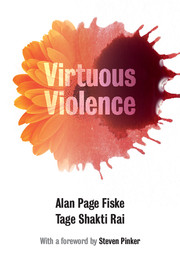Book contents
- Frontmatter
- Dedication
- Contents
- Figures and tables
- Foreword
- Warm thanks
- The point
- 1 Why are people violent?
- 2 Violence is morally motivated to regulate social relationships
- 3 Defense, punishment, and vengeance
- 4 The right and obligation of parents, police, kings, and gods to violently enforce their authority
- 5 Contests of violence: fighting for respect and solidarity
- 6 Honor and shame
- 7 War
- 8 Violence to obey, honor, and connect with the gods
- 9 On relational morality: what are its boundaries, what guides it, and how is it computed?
- 10 The prevailing wisdom
- 11 Intimate partner violence
- 12 Rape
- 13 Making them one with us: initiation, clitoridectomy, infibulation, circumcision, and castration
- 14 Torture
- 15 Homicide: he had it coming
- 16 Ethnic violence and genocide
- Chapter 17 Self-harm and suicide
- 18 Violent bereavement
- 19 Non-bodily violence: robbery
- 20 The specific form of violence for constituting each relational model
- 21 Why do people use violence to constitute their social relationships, rather than using some other medium?
- 22 Metarelational models that inhibit or provide alternatives to violence
- 23 How do we end violence?
- 24 Evolutionary, philosophical, legal, psychological, and research implications
- The dénouement
- References
- Index
4 - The right and obligation of parents, police, kings, and gods to violently enforce their authority
Published online by Cambridge University Press: 05 December 2014
- Frontmatter
- Dedication
- Contents
- Figures and tables
- Foreword
- Warm thanks
- The point
- 1 Why are people violent?
- 2 Violence is morally motivated to regulate social relationships
- 3 Defense, punishment, and vengeance
- 4 The right and obligation of parents, police, kings, and gods to violently enforce their authority
- 5 Contests of violence: fighting for respect and solidarity
- 6 Honor and shame
- 7 War
- 8 Violence to obey, honor, and connect with the gods
- 9 On relational morality: what are its boundaries, what guides it, and how is it computed?
- 10 The prevailing wisdom
- 11 Intimate partner violence
- 12 Rape
- 13 Making them one with us: initiation, clitoridectomy, infibulation, circumcision, and castration
- 14 Torture
- 15 Homicide: he had it coming
- 16 Ethnic violence and genocide
- Chapter 17 Self-harm and suicide
- 18 Violent bereavement
- 19 Non-bodily violence: robbery
- 20 The specific form of violence for constituting each relational model
- 21 Why do people use violence to constitute their social relationships, rather than using some other medium?
- 22 Metarelational models that inhibit or provide alternatives to violence
- 23 How do we end violence?
- 24 Evolutionary, philosophical, legal, psychological, and research implications
- The dénouement
- References
- Index
Summary
Here is a Chinese story that takes place in the Zhou dynasty (1256–1046 BCE), as set down in the third century CE:
A man, Ho, offered a jade matrix as a gift to King Li, and later again to King Wu. Each king’s jeweler failed to recognize the gem in the matrix, and each king ordered one of Ho’s feet amputated for the apparent insult. Hearing that Ho was weeping, King Wu sent a retainer to discover why. The retainer inquired, “Many people in the world have had their feet amputated – why do you weep so piteously over it?” He replied “I do not grieve because my feet have been cut off. I grieve because a precious jewel is dubbed a mere stone, and a man of integrity is called a deceiver. This is why I weep.”
(Han Fei Tzu, c. 235 CE; quoted in Collins, 1974: 415–16)Ho grieved that an act of deferential respect had been mistaken for an offense, while taking it for granted that a king may order his foot amputated for insulting him.
Cultural implementations of AR very often empower and obligate superiors to hurt subordinates. For long periods of history, men have been entitled to strike or beat their wives and force them to have sex; parents have been entitled to whip their children; schoolmasters have exercised the right to rap their pupils’ knuckles, twist their ears, or cane them; military officers have been authorized to strike or flog soldiers and sailors; slave-owners have been freely permitted to beat and rape slaves; and, in general, elites have had a great deal of latitude to inflict physical abuse on lower social classes. Often superiors have the authority to harm at their whim, merely to enact their authority: violence is an integral component of the conduct of these AR relationships. Much more widespread is the authority for the corporal punishment of disrespect and, especially, disobedience: violence is the crucial, prototypical, traditional means for redressing transgressions of AR. These are not just permissions: superiors are often required to inflict corporal punishment as part of the correct performance of their duties. That is, in many AR contexts in many cultures, the necessary, natural, and proper exercise of authority entails inflicting pain on subordinates, sometimes to the point of severe distress – and sometimes so as to inflict permanent injury or death.
- Type
- Chapter
- Information
- Virtuous ViolenceHurting and Killing to Create, Sustain, End, and Honor Social Relationships, pp. 42 - 59Publisher: Cambridge University PressPrint publication year: 2014

